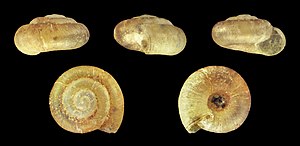Point snail
| Point snail | ||||||||||||
|---|---|---|---|---|---|---|---|---|---|---|---|---|

Punctum pygmaeum |
||||||||||||
| Systematics | ||||||||||||
|
||||||||||||
| Scientific name | ||||||||||||
| Punctum pygmaeum | ||||||||||||
| ( Draparnaud , 1801) |
The point snail ( Punctum pygmaeum ) is a species of snail in the family of point snails (Punctidae) from the suborder of land snails (Stylommatophora). The point snail is the smallest land snail found in Germany.
features
The right-hand wound, very small case is disc-shaped and measures only 1.2 to 1.6 mm in width and 0.6 to 0.8 mm in height. It has 3 to 3½ turns, which are moderately curved at the periphery and increase regularly. The turns are separated from each other by a deep seam. The mouth is rounded and is a little crooked to the axis of the coil. The edge of the mouth is thin and fragile, and not bent or thickened. The navel is large and open, the navel gap takes up about a quarter of the width of the case
The housing is yellowish-brown to reddish-brown in color. The surface shows very dense, very fine strips of growth at regular intervals. This gives the case a silky, shiny surface.
The soft body is dark gray to blackish. The jaw consists of individual non-fused platelets.
Geographical distribution and habitat
The distribution area extends over the whole of Europe, from southern Spain, Sicily and Crete to northern Scandinavia, from the British Isles to far into Russia. The distribution area probably even extends far into North Asia. In the Far East, however, it is represented by Punctum ussuriense . In the Alps, the animals soar up to 2500 m above sea level. In Bulgaria they are still found at an altitude of 1500 m above sea level.
The animals prefer to live in the litter of deciduous forests, in modern wood, under the bark of dead and fallen trees, under stones and other dry to moist locations with dense vegetation. They are rarely found in open habitats. The species is rock-indifferent and also occurs in and on the acidic soils of birch forests. However, it is usually much more common on chalky soils.
Way of life
The animals are hermaphrodites that usually pollinate each other. But self-fertilization is possible. According to laboratory tests, the animals lay only a few (up to 16, mean 6) eggs between May and September, but comparatively very large eggs individually in the soil. The melon-shaped eggs have a diameter of 0.4 to 0.5 mm, i.e. about a third of the width of the case. The egg shell is transparent and has longitudinal ribs. The young hatch on average after 15 to 20 days with a housing diameter of 0.49 mm. However, the development or the hatching time after oviposition is very different because the eggs are retained in the mantle cavity for different lengths of time. Occasionally, young animals can hatch from the eggs just one day after laying eggs. The animals grow to a diameter of 1.3 to 1.4 mm within 50 to 60 days until sexual maturity is reached. After reaching sexual maturity, the animals continue to grow, but the rate of growth decreases sharply. The average lifespan under laboratory conditions is 170 days. In the great outdoors, there are certainly months of winter rest and / or oversummer. The rapid growth and reaching sexual maturity after about 2 months theoretically allow several generations per year. So far, however, there are no observations from the wild.
Taxonomy
The taxon was first described in 1801 by Jacques Philippe Raymond Draparnaud as the Helix pygmaeum . It is widely recognized today.
The extinct taxon Punctum propygmaeum Andreae, 1904 from the Pannonian and Pontian (Upper Miocene) was placed by Lueger as a subspecies to Punctum pygmaeum . The MolluscaBase lists this taxon as an independent species.
Danger
The species is not considered endangered in Germany or in Europe as a whole.
literature
- Michael P. Kerney, RAD Cameron & Jürgen H. Jungbluth: The land snails of Northern and Central Europe. 384 pp., Paul Parey, Hamburg & Berlin 1983, ISBN 3-490-17918-8 , pp. 137/38.
Individual evidence
- ↑ Jürgen H. Jungbluth and Dietrich von Knorre: Trivial names of land and freshwater mollusks in Germany (Gastropoda et Bivalvia). Mollusca, 26 (1): 105-156, Dresden 2008 ISSN 1864-5127 , p. 121.
- ↑ a b c Francisco W. Welter Schultes: European non-marine molluscs, a guide for species identification = identification book for European land and freshwater mollusks. A1-A3 S., 679 S., Q1-Q78 S., Göttingen, Planet Poster Ed., 2012 ISBN 3-933922-75-5 , ISBN 978-3-933922-75-5 (p. 202)
- ↑ a b Bruno Baur: Growth and reproduction in the minute land snail Punctum pygmaeum (Draparnaud). Journal of Molluscan Studies, 55 (3): 383–387, 1989 PDF (ResearchGate) (accessed June 16, 2018).
- ^ Jacques Philippe Raymond Draparnaud: Tableau des mollusques terrestres et fluviatiles de la France. 116 S., Renaud; Bossange, Masson & Besson, Montpellier & Paris, 1801 Online at Biodiversity Heritage Library , p. 93.
- ↑ AnimalBase: Punctum pygmaeum (Draparnaud, 1801) (accessed June 16, 2018)
- ↑ MolluscaBase: Punctum pygmaeum (Draparnaud, 1801)
- ↑ Fauna Europaea: Punctum (Punctum) pygmaeum (Draparnaud, 1801)
- ↑ Klaus Bogon: Landschnecken biology, ecology, biotope protection. 404 p., Natur Verlag, Augsburg 1990 ISBN 3-89440-002-1 , p. 156
- ↑ a b Vollrath Wiese: The land snails of Germany. 352 pp., Quelle & Meyer, Wiebelsheim 2014 ISBN 978-3-494-01551-4 (p. 156)
- ^ Josef Paul Lueger: The land snails in the Pannon and Pont of the Vienna basin. I. Systematics II. Sites, stratigraphy, fauna provinces. Memoranda of the Austrian Academy of Sciences, Mathematical and Natural Science Class, 120: 1–156, Vienna 1981 Preview on Google Books
- ↑ MolluscaBase: Punctum propygmaeum (Andreae, 1904)
